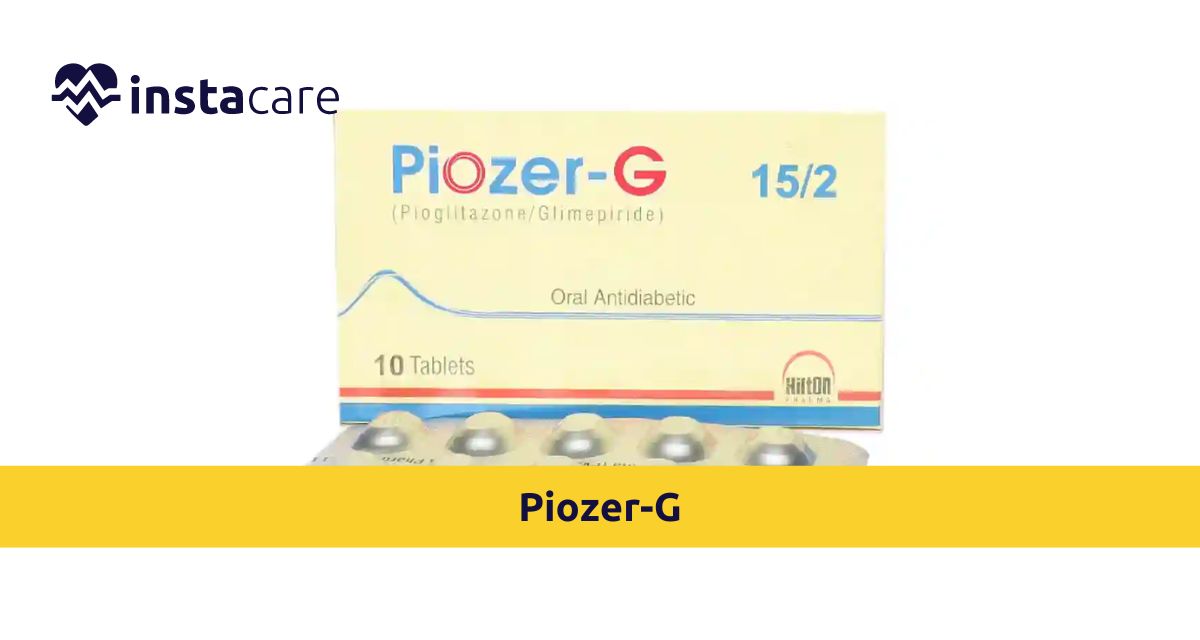Piozer-G 15mg is used quite extensively in the therapy of
particular disorders, more specifically, those conditions associated with
diabetes and metabolic disorders. To ensure informed decisions are reached
concerning its usage, there is a need for well-informed importance, benefits,
risks, and uses of Piozer-G 15 mg not just by the health professional but also
by the patient. It is continued by detailed information regarding the critical
information on the role of Piozer-G 15 mg in therapy, benefit, possible side,
and adverse effects and considerations of effective use.
What is Piozer-G 15mg?
Piozer-G 15mg is a pharmaceutical preparation containing two
active ingredients: pioglitazone and glimepiride. Both of the constituents
co-act to sustain blood sugar in the human body, more specifically in type 2
diabetics. Pioglitazone is from the drug category of thiazolidinedione, and
Glimepiride falls into the drug category of sulfonylurea. This brings
multidimensional benefits toward controlling blood glucose levels and
maintaining better glycemic control.
Importance of Piozer-G 15 mg
1. Treatment of Type 2 Diabetes
Piozer-G 15mg is mainly used in the treatment of type 2
diabetes, a condition that develops from resistance to insulin and high blood sugar. It prescribes medication to lower blood sugar in people who cannot
control it to a sufficient level with only diet and exercise. Piozer-G 15 mg
combines pioglitazone with glimepiride, which are two of the most important
aspects of glucose management and, as such, create an effective pathway for
diabetes management.
2. Synergistic Effect
The combination of Pioglitazone and Glimepiride in Piozer-G
15mg acts in a synergistic manner to control blood sugar levels. Pioglitazone
works in the fashion of enhancing cells' sensitivity to insulin, thereby
enabling it to maximize the benefit of used insulin. However, Glimepiride works
in a manner to increase additional insulin release from the pancreas, which, in
turn, controls levels of blood glucose. Thus, the resultant effect will be
improved glycemic control.
Advantages of Piozer-G 15mg
1. Effective Glycemic Control
One of the chief benefits that come from Piozer-G 15 mg is
effective blood sugar control. In combination with Pioglitazone and Glimepiride
in Piozer-G 15mg, the medicament brings into action two varied mechanisms that
are interrelated in controlling blood glucose. While Pioglitazone acts on
enhancing peripheral insulin sensitivity, on the other hand, Glimepiride does
so through elevating beta insulin secretion from pancreatic beta cells. This
dual mechanism helps in practically better glycemic control than monotherapy
with the drug.
2. HbA1c Improvement
HbA1c is a marker outlining the average blood glucose over
time. Piozer-G 15mg can improve the HbA1c levels and, hence, better control of
glucose in the long term. Reduction in HbA1c is important to decrease the risk
of complications of diabetes like cardiovascular disease, neuropathy, and
nephropathy.
3. Combination Convenience
Thus, the single-tablet combination of Pioglitazone and
Glimepiride makes this an all-in-one combination that will greatly benefit
several diabetic patients who, instead of two different medicines, can get only
one prescription because of this one pill. This could after all make the
therapeutic regimen much more tolerable, finally resulting in good compliance
with lesser chances of missing doses.
4. Possible Cardiovascular Benefits
Some of the studies even go to the extent of
unscientifically relating Pioglitazone to the mechanism that prevents heart
diseases, in addition to the glucose-lowering property. Therefore, with the
addition of Pioglitazone in therapy, Piozer-G 15mg might add benefits to the Health
of cardiovascular to the diabetes patients.
Risks and Side Effects
1. Common Side Effects
As with all medicines,15mg Piozer-G can cause side effects.
Common side effects with the drug include nausea, headache, dizziness, and
increase in weight, which are mainly of mild nature and tend to decrease with
time as the body habituates to the drug. However, he/ she needs to visit the
health care provider if the side effects are dreadful and nagging
2. Hypoglycemia
Glimepiride, as a constituent of Piozer-G 15mg, is capable
of producing hypoglycaemia. Patients undergoing treatment with Piozer-G 15mg
should have adequate information about the different manifestations of
presenting symptoms in the event of hypoglycaemia: sweating in great amounts,
tremors/shaking, confusion, disorientation as well as dizziness. Dose should be
administered appropriately based on the need, and blood glucose monitoring
should be done frequently, so the patient can be saved from risk factors
leading to hypoglycaemia.
3. Weight Gain
One of the documented side effects of the pioglitazone
component of Piozer-G 15 mg is weight gain. This side effect of the medication
might occur in the form of an imbalance in the distribution of fat or retention
of fluid. It must monitor the weight and, when concerned, the patient should
discuss with the healthcare provider how they might resolve this, probably
through changes in medication and lifestyle.
4. Risk of Fluid Retention and Edema
Pioglitazone can be prescribed with edema, particularly in
the lower extremities, as one of its possible side effects. A patient already
having a cardiac history or other medical illness altering the works of the
heart and its functions should still be given more caution even though
pioglitazone can be prescribed. Monitoring and follow-up with the clinician are
very important in the management and treatment of any indication and
manifestation of fluid retention with edema.
5. Possible Effects on Liver
Both Pioglitazone and Glimepiride are known to affect liver
function. Regular tests of liver function should be done by the clinician to
identify any symptoms of abnormality of liver. With identified liver function
abnormality, the clinician can either adjust the dosage of the drug or use
other forms of treatment.
Uses of Piozer-G 15mg
1. Type 2 Diabetes Uncontrolled Treatment
Piozer-G 15mg is mainly indicated in the treatment of type 2
diabetes not satisfactorily controlled by diet and exercise alone. It is
usually indicated through patients in whom modest control of the blood sugar
level cannot be attained with other oral hypoglycemic agents. Pioglitazone and
Glimepiride combination in Piozer-G 15mg gives a wholistic approach in
attaining better glycemic control.
2. Adjunct Therapy
Piozer-G 15 mg may be added to other anti-diabetic medications
as an adjunct therapy. There are diabetes patients who are controlled by one
medication, but their glucose is not optimal due to that medication. Piozer-G
15 mg may be added in combination with another medication to balance out this
shortcoming of effectiveness. All of this must be done in conjunction with a
healthcare professional who can and should determine which medications need to
be combined to manage the disease state appropriately.
3. Management of Insulin Resistance
15 mg Piozer-G contains one of the ingredients active in
reducing insulin resistance. From this perspective, the latter has been known
to act as a prime determinant of type 2 diabetes and may affect the blood
glucose levels adversely. In this regard, pioglitazone has, through better
insulin sensitivity, reversed the basic pathology, leading to better glycemic
control.
4. Cardiovascular Health
Apart from management against blood glucose levels, cardiac
health can also benefit through Piozer-G 15mg because of the Pioglitazone
component in it. Cardiovascular risk is one of the major threats people with
type 2 diabetes have to steer clear of; therefore, the possibility of the
medicine bringing this risk down could be a side advantage.
Conclusion
Piozer-G 15mg is a very useful drug in managing additional
type 2 diabetes; besides decent glycemia control, it combines Pioglitazone with
Glimepiride. The combination therapy offers a spectrum of benefits; just like
most other drugs, this combination therapy improves the blood sugar level, might
be useful for cardiovascular health, and results in fewer complications. Risks
and probable side effects, on the other hand, exist for this medicine. A
patient should understand among what these are and work out with their doctor
how to take the medicine effectively and safely.
Please book an appointment with the best Diabetologist in Lahore, Karachi, Islamabad, and all major cities of Pakistan through InstaCare, or call our helpline at 03171777509 to find the verified doctor for your disease.

